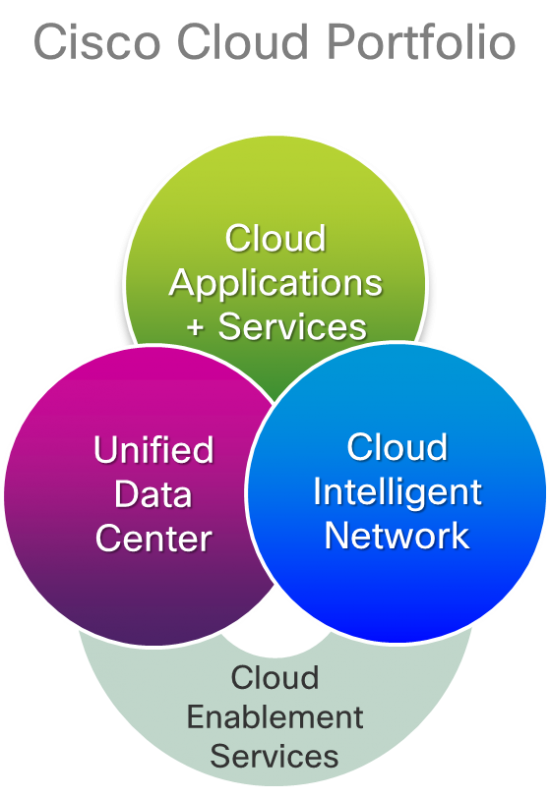 Among all the Megatrends that have significant implications from an infrastructure perspective (as discussed here), the one that customers in EMEAR currently expect the most from Cisco is Clouds. Both in terms of technical guidance as well as architectural innovations.
Among all the Megatrends that have significant implications from an infrastructure perspective (as discussed here), the one that customers in EMEAR currently expect the most from Cisco is Clouds. Both in terms of technical guidance as well as architectural innovations.
In the Cisco Cloud approach, intelligence in the network can help ensure delivery of cloud services, provide access and services to the right users, and offer the flexibility to connect with public, hybrid, and community clouds.
As shown in the illustration to the right, three main elements must be considered to build an efficient cloud. In addition, the network needs to provide dynamic access to these resources, and the Cloud applications and services must deliver anywhere, anytime access.
With the emergence of Cloud architectures, innovation is required within the network to allow IP to gain two critical features not natively provided by IP today: IP mobility and the Virtual Private Network (VPN).
With Clouds, applications can seat anywhere, but they can also be moved conveniently at any time. This means the network must be able to deal with resource mobility to deliver on the promise of clouds. And that is what LISP addresses.
For a LISP primer, you can start with the video below:
LISP is an overlay routing protocol in the sense that it allows decoupling of the core transport, which can be any IP transport method from the edge, which can be any IP applications site. LISP is intended to allow dynamic resource provisioning independent of the network infrastructure. In short, any IP address can be positioned anywhere it is needed.
LISP capabilities are key to successful Cloud usage. Their Virtualization capability allows multi-tenancy while mobility is mandatory for flexible provisioning.

Multi-tenancy
By definition, Cloud providers offer services to a very large number of customers, and all these services must be provided in the same Data Center and onto the same network. It is therefore as important to virtualize the compute resource as it is to virtualize the network.
Before LISP, MPLS was the only technology able to offer multi-tenancy. Now, LISP brings IP multi-instance transport, allowing IP for multi-tenants in the Cloud.
Virtual Private Cloud is the model for providing Cloud services to the Enterprise, and the access network between provider and customer may not be virtualized. LISP is an appealing technology to provide multi-instances over any type of IP access network. If security is required due to public transport, then encryption is supported on LISP.
Mobility
There are two ways to consider mobility over the network in the Cloud. One way, inherited from the existing networking models, is to have the provisioning system allocate the compute to one home Data Center site from which the resource could be moved to any other site for operations needed. The other way, which is more innovative, is to totally decouple the compute address space allocation from the physical site where it will be run. Compute to network decoupling is one challenge that LISP can help solve.
In addition, mobility is a key enabler for hybrid clouds. Hybrid Cloud service consists of establishing a relationship between the customer data center and the provider data center. This relationship allows cloud bursting, migration, backup services, and others. LISP allows users to extend the customer subnet to any place in the provider Cloud that can create the required relationship.
Cloud is about the mobility of the compute, but at large scale this will clearly have an impact to the network. LISP, with its pull model, is there to handle such a huge scaling factor.
Building a Hybrid Cloud Using LISP
Traditionally, outsourcing services needed to fully dedicate a Data Center to a provider. With Software-as-a-Service (SaaS), providers can offer application outsourcing. With Infrastructure-as-a-Service (IaaS), providers can offer partial DC hosting. It is important to note that the success of such approaches is linked to how easily the provider Cloud can be integrated with the customer existing resources.
Hybrid Cloud is about interconnecting the Provider Cloud to the Enterprise Private Cloud.
Two types of traffic have to be considered with the Hybrid Cloud. One is the inter-subnet-routed traffic that is mostly a LISP VPN transported type of traffic; the other one is the intra-subnet traffic. Intra-subnet traffic is an interesting new paradigm that ensures subnet continuity for cloud insertion by allowing providers to insert their application right into the heart of the customer data center. IP routing is not really able to provide such a subnet extension. In the last few years, a new design approach has arisen on the market, which is called Data Center Interconnect (DCI) where VLANs are extended over the long distance network allowing extended subnets. The big question is then: is this architecture realistic in a Cloud approach where both ends of the DCI would not belong to the same owner? Can the broadcast domain of an enterprise really be extended to the service provider’s domain? With its ability to extend subnets connections without extending VLANs, LISP is certainly an appealing solution.
To review, LISP is a protocol built for the Cloud, especially the Public Cloud, the Virtual Private Cloud, and the Hybrid Cloud as it offers two new fundamental capabilities to IP: Virtualization and Mobility. LISP offers both of these in a scalable manner.
If you have not yet, I would encourage you to have a look at Omar’s LISP posts. They’re a good resource. LISP is one of the many innovations Cisco is bringing to the industry to ease the journey to Clouds from an infrastructure perspective.
Are you already familiar with LISP? If so, what is your view? What are some of the use cases where LISP brings the most benefit to you?
Many thanks!


CONNECT WITH US